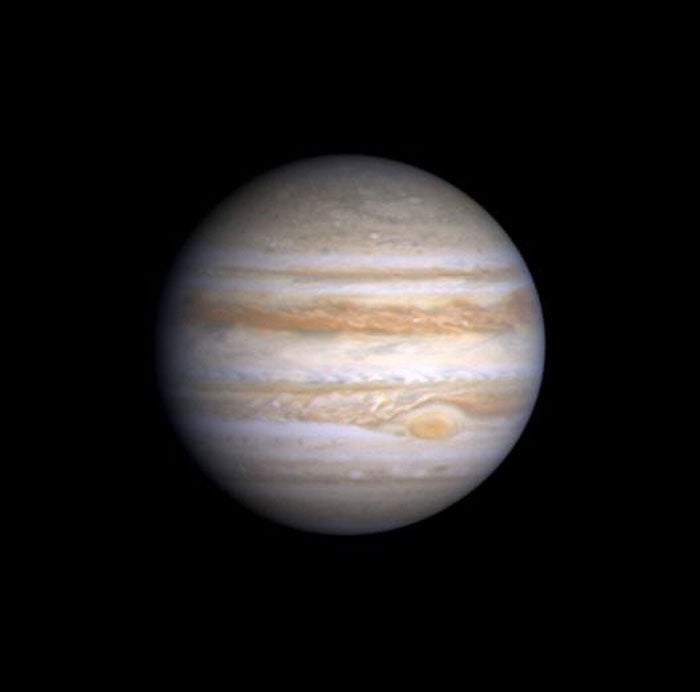

Intricate detail of Jupiter’s dynamic atmosphere shows through telescopes of all sizes, especially in the weeks around its early March opposition.
NASA/ESA/A. Simon (GSFC)
March brings the onset of spring and the return of warmer weather to much of North America. The balmy conditions should prove enticing for observers eager to sample the planetary treasures that were largely lacking during winter’s cold nights. The stars of the show are Jupiter and Mars. The former hits its peak in March and remains visible all night while the latter dominates the morning sky as it enters prime viewing season. And don’t overlook stunning Saturn, which shares the predawn stage with Mars.
Let’s begin our monthly tour in the western sky as darkness falls. You’ll need binoculars if you want to spot Uranus. On March 1, the ice giant world stands nearly 20° above the horizon as the last hints of twilight fade away.
Uranus shines at magnitude 5.9 among the background stars of Pisces. To find it, first locate 2nd-magnitude Alpha (α) Andromedae, the star marking the top corner of the Great Square of Pegasus. Then scan 25° to the left and pick up 4th-magnitude Epsilon (ε) Piscium. The planet lies 2° to Epsilon’s left. The nicest view occurs March 10, when Uranus appears 2° due north of a slender crescent Moon.
The planet sinks lower with each passing day and disappears into the Sun’s glare after midmonth. That’s too bad because it means observers won’t be able to see it when it passes less than 1° south of Mercury on the 31st. The innermost planet then shines at magnitude –1.6, however, and may show up through binoculars if you have an excellent sky. Mercury will have its finest evening appearance of 2016 in April.
The western evening sky’s meager offerings mean that most observers will focus their attention to the east. Jupiter reaches opposition and peak visibility March 8. Because the planet lies opposite the Sun in our sky, it rises at sunset and sets at dawn. The planet also shines brightest at opposition. At magnitude –2.5, it appears 2.5 times more luminous than the night sky’s brightest star, Sirius. Jupiter spends March in southern Leo, and within 1° of 4th-magnitude Sigma (σ) Leonis during the month’s first 10 days.
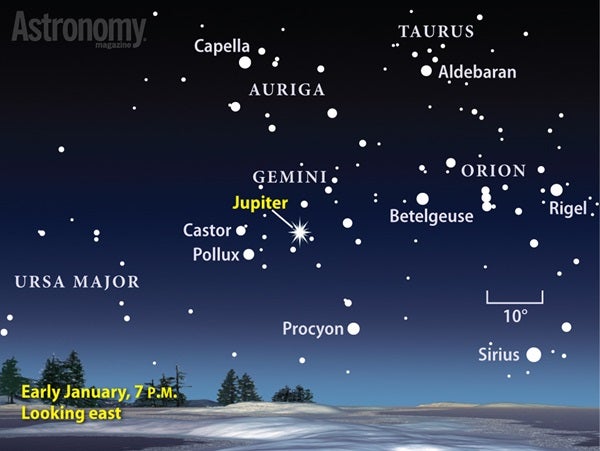
The solar system’s largest planet resides among the background stars of Leo the Lion at its March 8 peak.
All illustrations: Astronomy: Roen Kelly
Opposition also means that Jupiter lies closest to Earth and thus appears largest when viewed through a telescope. The planet’s disk spans 44″, big enough that any scope will reveal atmospheric details. Look for two prominent dark bands straddling a brighter equatorial zone. A small telescope typically shows these belts with sharply defined edges. Larger instruments reveal turbulence.
Although Jupiter’s atmosphere can keep an observer busy for hours, don’t overlook the four bright moons that endlessly circle the planet. An individual moon spends most of its time either east or west of Jupiter, but once each orbit it passes in front of the planet in what astronomers call a transit. During a transit, the moon also casts its shadow onto the jovian cloud tops, where it appears as a small-yet-distinct black dot.
A moon and its shadow nearly overlap at opposition because the light source (the Sun) lies directly behind our vantage point. Observers in the eastern half of North America can see this happen twice the evening of March 7. Europa and its shadow transit Jupiter’s disk for nearly three hours starting around 6:10 p.m. EST. Innermost Io and its shadow follow shortly thereafter, crossing the cloud tops from 7:28 to 9:43 p.m.
These two repeat their transits in magnificent fashion the night of March 14/15 but with an added twist: You’ll see Io overtake Europa as the transit nears its end. Europa begins to transit at 9:27 p.m. EDT, and its shadow arrives on the disk 19 minutes later. Io’s transit starts at 10:12 p.m. with its shadow following nine minutes after.
Now the race is on. During the next two hours, Io catches up to its neighbor. At around 11:15 p.m., the two dark shadows appear about halfway across the planet with Io itself midway between them and Europa farthest west. Io passes Europa’s shadow shortly before midnight when the inner moon and the two shadows form a tight triangle. Europa’s transit ends at 12:13 a.m. followed 14 minutes later by Io’s.
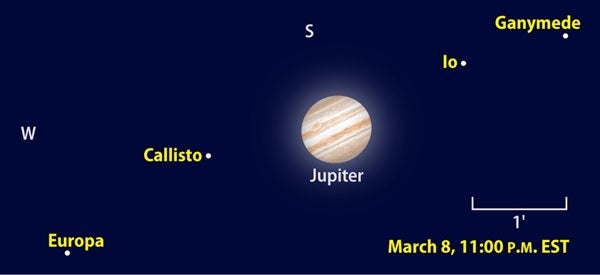
Four bright moons string out to Jupiter’s east and west on the night the giant planet reaches opposition and peak visibility.
As Jupiter rides high in the south shortly after midnight, Mars rises in the southeast. The Red Planet begins March in eastern Libra and crosses into the narrow northern section of Scorpius on the 13th. Three mornings later, it passes 0.2° northeast of the fine double star Beta (β) Scorpii.
Mars will reach opposition in May, and the approach to this milestone brings major changes in the world’s appearance. The Red Planet doubles in brightness during March, rising from magnitude 0.3 to –0.5. It easily outshines Antares, Scorpius’ brightest star, which lies 9° southeast of the planet at midmonth. Note the similar colors of the two objects, which is how Antares (meaning “rival of Mars”) got its name.
The changes in Mars’ appearance through a telescope are no less dramatic. The planet’s diameter swells from 8.7″ to 11.7″ during March. Seasoned Mars observers consider 10″ big enough for 6-inch scopes to reveal significant surface details. The Red Planet crosses this threshold at midmonth and will remain above it through early September. (It peaks in late May at nearly double this size.) The best views come when Mars lies highest in the south as morning twilight begins.
While spring is just starting in Earth’s Northern Hemisphere, that season is well underway on Mars. This means the Red Planet’s north polar cap stands out as a white patch on the limb. The most prominent dark feature is Syrtis Major. For observers in North America, this region lies near the world’s western limb in early March. Because a day on Mars lasts 37 minutes longer than one on Earth, Syrtis Major rotates into better view with each passing morning. By mid-March, it stands on the eastern limb as twilight begins.
You’ll also notice that Mars sports a distinct phase. On March 1, sunlight illuminates 90 percent of the Earth-facing hemisphere and the western limb appears less distinct. The phase grows to 93 percent lit by month’s end.
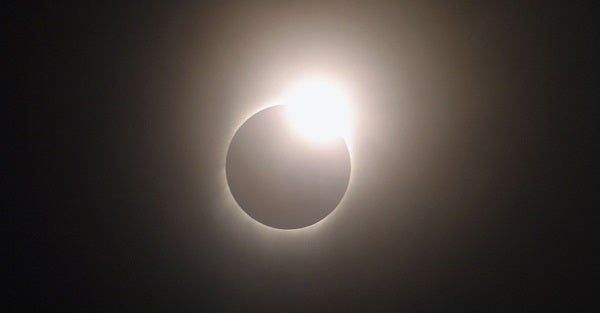
Observers in parts of Indonesia and the Pacific Ocean can witness nature’s grandest spectacle — a total solar eclipse — on March 8/9.
Nick Howes
Roughly an hour after Mars rises, Saturn pokes above the horizon. The ringed planet’s yellowish hue contrasts nicely with ruddy Mars and Antares nearby. And at magnitude 0.4, Saturn appears intermediate in brightness between its neighbors. The ringed world has no rivals among the background stars of southern Ophiuchus.
As with Mars, the best time to view Saturn through a telescope is when it lies highest in the south as twilight starts. The gas giant’s relatively bland disk measures 17″ across the equator while the rings span 38″ and tilt 26° to our line of sight.
Any scope immediately reveals Saturn’s biggest and brightest moon, Titan. The 8th-magnitude, haze-covered satellite lies due north of Saturn on March 2 and 18 and due south of the planet on the 10th and 26th. Three 10th-magnitude moons huddle closer to the rings.
Although Venus rises an hour before the Sun in early March, it doesn’t gain altitude quickly. Even 30 minutes later, it appears only 5° high in the east-southeast. Still, it shines at magnitude –3.9 and shows up in bright twilight. A telescope reveals its 11″-diameter disk, which appears 91 percent illuminated. By month’s end, the inner planet rises just a half-hour before sunrise and will be harder to spot.
The month’s most spectacular event occurs March 9 over a small part of Indonesia and the Pacific Ocean. Shortly after the Sun rises across portions of Sumatra, Borneo, and Sulawesi, the Moon passes directly in front of our star to create a total solar eclipse. Those who venture to the center line can witness up to three minutes of totality.
People in Hawaii will experience a substantial partial eclipse late on the afternoon of March 8 (seemingly a day early because the Moon’s shadow has crossed the International Date Line). From Honolulu, the eclipse lasts from 4:33 to 6:33 p.m. HAST. Maximum occurs at 5:37 p.m., when the Moon covers 70 percent of the Sun’s diameter and the pair stands 14° above the western horizon.
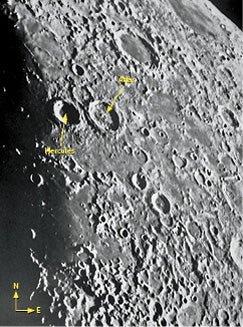
Craters named for mythological strongmen stand out on the terminator of a waxing crescent Moon.
Consolidated Lunar Atlas/UA/LPL
STRIKING CRATERS STAND SIDE BY SIDE
The northeastern quadrant of a waxing crescent Moon features a prominent pair of large craters. Named for mythological musclemen, Atlas and Hercules have appropriately striking features.
Their chiseled forms seem to pop out the evening of March 12 as the Sun rises in the lunar sky. Atlas, the one closer to the limb, sports a rough floor and a central peak. Hercules lies immediately to its west, straddling the dividing line between night and day known as the terminator. On the 12th, the inner walls of Hercules’ western rim face the brilliant Sun while their eastern counterparts remain in deep shadow. Return to this crater on the 13th, and its floor will be on full display. Surprise: It is a pool of frozen lava with the barest hint of a central peak and a sharp-rimmed crater just south of center.
An apron of debris surrounds Atlas and Hercules. Can you tell which one drapes over the other? It may help to look again under reversed lighting conditions, when the setting Sun illuminates the craters’ eastern flanks March 26. Don’t despair if you can’t figure it out — even scientists disagree as to which crater formed first.
Luna slowly turns its nose up at us beginning on the 18th. Key in on the limb northeast of Hercules and watch as the dark floor of Mare Humboldtianum shifts farther out of sight from night to night. The tilt of the Moon’s axis isn’t really changing. Rather, its equator doesn’t coincide with its orbit around Earth, so we see it from slightly different perspectives. Astronomers call this apparent nodding motion libration.
Anytime after First Quarter phase (March 15) is close to high noon for Atlas and Hercules. Without the highlighting effect of shadows, Atlas practically disappears. In contrast, Hercules’ lava lake stands out next to its light-hued neighbor.
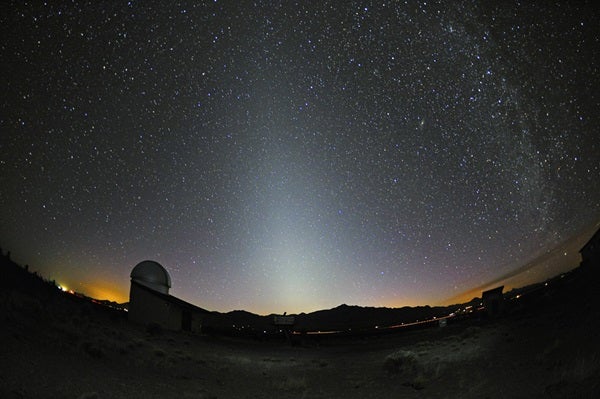
The first 10 days of March provide observers with a great chance to see the glow of solar system dust after evening twilight fades.
Stephen G. Cullen
DUSTY DEBRIS SETS THE EVENING AGLOW
March finds us in the meteor calendar’s longest gap. Just a few minor showers and occasional sporadics sprinkle the sky. But you still can see the dust from countless comets and pulverized asteroids. This material fills the inner solar system in a disk that coincides with the planets’ orbital plane, or ecliptic. Sunlight illuminates the dust, creating a faint glow visible under clear dark skies after twilight ends. This so-called zodiacal light shows up best now because the ecliptic makes a steep angle to the western horizon after sunset.
Look to the west after darkness falls during March’s first 10 days, when the Moon is out of the sky. The cone-shaped zodiacal light appears a little dimmer than the Milky Way and reaches from the horizon up toward the Pleiades star cluster.
| WHEN TO VIEW THE PLANETS | ||
| Evening Sky | Midnight | Morning Sky |
| Mercury (west) | Jupiter (south) | Venus (east) |
| Jupiter (east) | Mars (south) | |
| Uranus (west) | Jupiter (west) | |
| Saturn (south) | ||
| Neptune (east) | ||
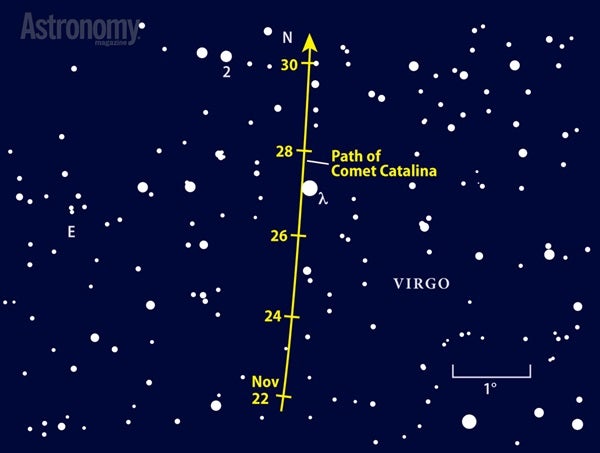
This 8th-magnitude dirty snowball, which recently arrived from the Oort Cloud, makes its way from Camelopardalis to Perseus during March.
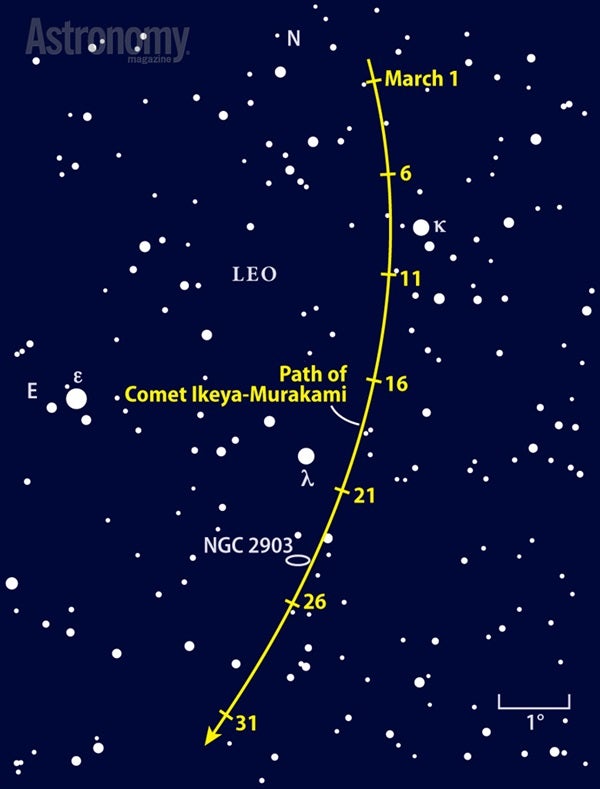
This periodic visitor to the inner solar system should glow at 8th magnitude in March as it heads south near the top of Leo’s Sickle asterism.
TANDEM TAILS AND TRAITS
Observers often struggle to find one decent comet to observe. But in March, two perfectly good ones appear in the evening sky. Except for the fact that Comet Catalina (C/2013 US10) will never return to the inner solar system as it follows a hyperbolic orbit and Ikeya-Murakami (P/2010 V1) swings past the Sun every 5.4 years, these fraternal twins put on nearly identical displays this month.
Both should glow at a modest 8th or 9th magnitude, so a 4-inch scope under a dark sky will do an admirable job revealing the transformation of their tails. In typical comets, the expelled gas and dust forms a relatively flat V-shape. But on March 24, Ikeya-Murakami’s tail will appear as a slash of light as it turns edge-on to us. Coincidentally, Catalina strikes the same pose two nights later. The more nights you look, the smoother the transformation will seem. Unfortunately, a nearly Full Moon interferes with Ikeya-Murakami’s crossing.
Visual observers and imagers alike should plan for the brief dark-sky window the evening of March 25. Ikeya-Murakami then lies within 15′ of the bright spiral galaxy NGC 2903 in Leo. At the same time, Catalina perches halfway between the splendid star clusters NGC 1528 and NGC 1545 in the arm of Perseus.
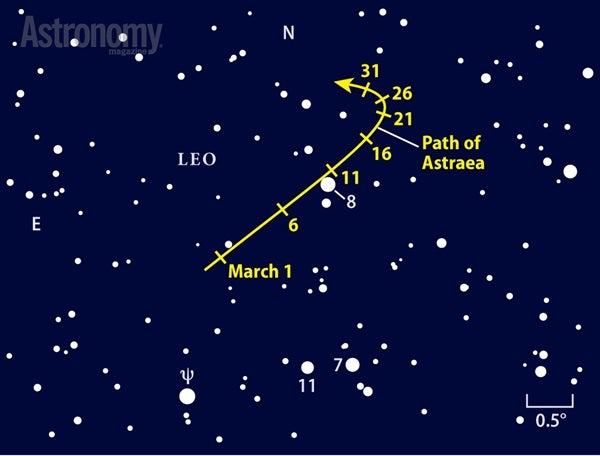
As minor planet Astraea fades from magnitude 9.3 to 10.1 in March, it passes through a star-poor region surrounding 6th-magnitude 8 Leonis.
STARING DOWN LEO THE LION
Flying high in the southeastern sky after nightfall, asteroid 5 Astraea floats in front of Leo’s face. It lies a short hop from the Lion’s heart, the 1st-magnitude blue-white star Regulus. Except for the nights of March 18–20, when moonlight interferes, spend some pleasant evenings striding alongside Astraea.
Your best guide star to this main-belt asteroid is 8 Leonis, a magnitude 5.7 star located 9° northwest of Regulus. Astraea remains within 1.5° of 8 Leo throughout March. Fortunately, this part of the spring sky is a long way from the Milky Way, so you should be able to tell pretty quickly which point of light you are seeking. At magnitude 9.3, Astraea glows brighter than most of the stars in this field. Don’t get confused on the 2nd, however, when our target masquerades as the faint companion of an 8th-magnitude double star just to its north. On the 10th, this 75-mile-wide world passes 0.1° north of 8 Leo.
If you’re feeling nostalgic and want to follow in the footsteps of Astraea’s discoverer, German amateur astronomer Karl Hencke, you have to prove to yourself that the object moves from one night to the next. In 1845, after 15 painstaking years of comparing eyepiece views to star charts, Hencke finally laid to rest the 40-year-old idea that the solar system held only four asteroids. He found 6 Hebe 19 months later, and soon the trickle of asteroid discoveries turned into a torrent.
Martin Ratcliffe provides planetarium development for Sky-Skan, Inc. from his home in Wichita, Kansas. Meteorologist Alister Ling works for Environment Canada in Edmonton, Alberta.









